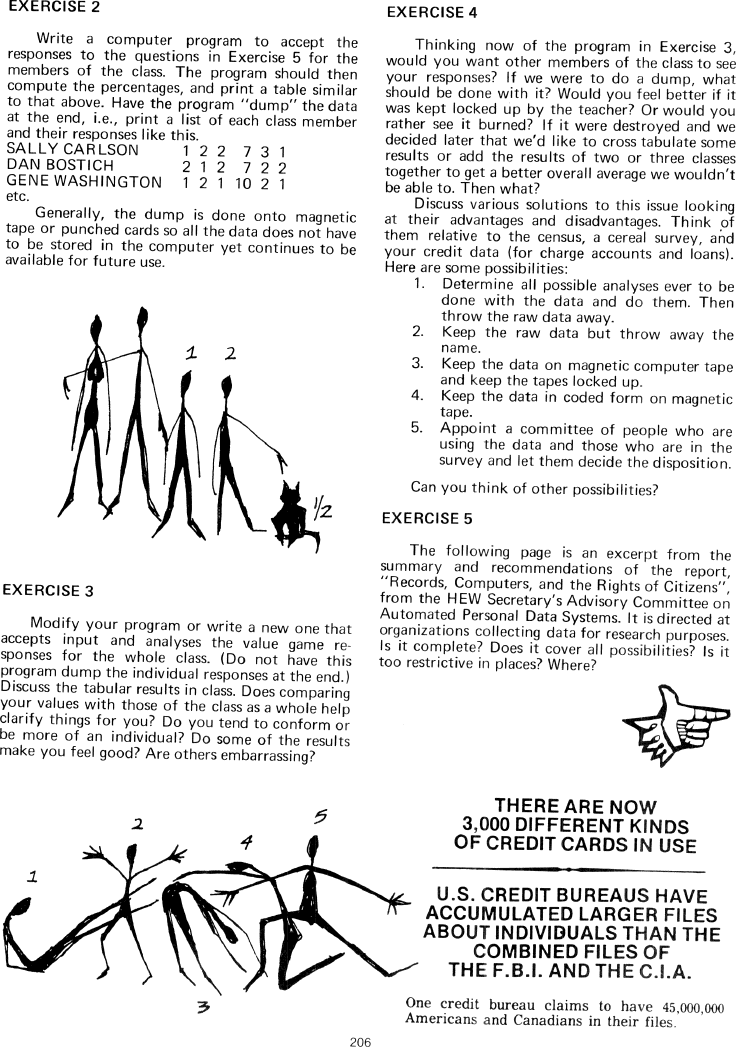The Best of Creative Computing Volume 1 (published 1976)
Surveys, The Census, and Privacy (computer programs to accept and analyze survey responses)

EXERCISE 2
Write a computer program to accept the responses to the questions in Exercise 5
for the members of the class. The program should then compute the percentages,
and print a table similar to that above. Have the program "dump" the data at the
end, i.e., print a list of each class member and their responses like this.
SALLY CARLSON 1 2 2 7 3 1
DAN BOSTICH 2 1 2 7 2 2
GENE WASHINGTON 1 2 1 10 2 1
etc.
Generally, the dump is done onto magnetic tape or punched cards so all the data
does not have to be stored in the computer yet continues to be available for
future use.
***
[image]1 2 1/2
***
EXERCISE 3
Modify your program or write a new one that accepts input and analyses the value
game responses for the whole class. (Do not have this program dump the
individual responses at the end.) Discuss the tabular results in class. Does
comparing your values with those of the class as a whole help clarify things for
you? Do you tend to conform or be more of an individual? Do some of the results
make you feel good? Are others embarrassing?
***
[image]1 2 3 4 5
***
EXERCISE 4
Thinking now of the program in Exercise 3, would you want other members of the
class to see your responses? If we were to do a dump, what should be done with
it? Would you feel better if it was kept locked up by the teacher? Or would you
rather see it burned? If it were destroyed and we decided later that we'd like
to cross tabulate some results or add the results of two or three classes
together to get a better overall average we wouldn't be able to. Then what?
Discuss various solutions to this issue looking at their advantages and
disadvantages. Think of them relative to the census, a cereal survey, and your
credit data (for charge accounts and loans).
Here are some possibilities:
1. Determine all possible analyses ever to be done with the data and do them.
Then throw the raw data away.
2. Keep the raw data but throw away the name.
3. Keep the data on magnetic computer tape and keep the tapes locked up.
4. Keep the data in coded form on magnetic tape.
5. Appoint a committee of people who are using the data and those who are in the
survey and let them decide the disposition.
Can you think of other possibilities?
***
EXERCISE 5
The following page is an excerpt from the summary and recommendations of the
report, "Records, Computers, and the Rights of Citizens", from the HEW
Secretary's Advisory Committee on Automated Personal Data Systems. It is
directed at organizations collecting data for research purposes. Is it complete?
Does it cover all possibilities? Is it too restrictive in places? Where?
***
[Image]
***
THERE ARE NOW
3,000 DIFFERENT KINDS
OF CREDIT CARDS IN USE
[Image]
U.S. CREDIT BUREAUS HAVE
ACCUMULATED LARGER FILES
ABOUT INDIVIDUALS THAN THE
COMBINED FILES OF
THE F.B.I. AND THE C.I.A.
One credit bureau claims to have 45,000,000 Americans and Canadians in their
files.
***
206


